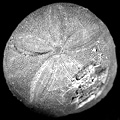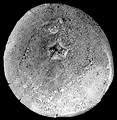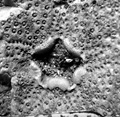The Echinoid Directory
Contributed by Dinesh Srivastava, May 2009
Rhyncholampas smithi Srivastava , Singh, Tiwari & Jauhri, 2008, p. 514
| Diagnostic Features |
|
|---|---|
| Distribution | Eocene (late Lutetian to early Bartonian); Meghalaya, India |
| Type | Holotype: Lucknow University Geology Department LUGD/I/2023; paratypes LUGD/I/2024 to LUGD/I/2026. Centre of Advanced Study in Geology, University of Lucknow, Lucknow. |
| Classification and/or Status | Cassiduloida; Cassidulidae A species of Rhyncholampas A. Agassiz, 1869 |
| Remarks | Rhyncholampas smithi differs from R. grignonensis (Defrance) described from the Eocene sediments of France (Kier, 1962) in lacking flat aboral surface and straight petal III. It differs from R. caroliensis (Twitchel) described from the middle Eocene sediments of North Carolina (Kier, 1980) in having higher test and less developed phyllodes. It can be distinguished with living R. pacificus (A. Agassiz) of American west Coast (tropical eastern Pacific Ocean) in having more convex aboral surface, less developed phyllodes and subpetaloid petal III. Kier, P. M. 1962. Revision of the cassiduloid echinoids. Smithsonian Miscellaneous Collections, 143(3): 1-262, 44 pls. Kier, P. M. 1980. The echinoids of the middle Eocene Warley Hill Formation, Santee Limestone and Castle Hayne Limestone of North and South Carolina. Smithsonian Contributions to Paleobiology, 39: 102 p., 22 pls. Srivastava, D. K., Singh, A. P., Tiwari, R. P. & Jauhri, A. K. 2008. Cassiduloids (Echinoidea) from the Siju Formation (late Lutetian-early Bartonian) of the South Garo Hills, Meghalaya, India, Revue de Paleobiologie, 27(2): 511-523. |





